Hoya (Wax Plant) Houseplant Repotting: When, How & The Mix To Use
I really do need to get more hoyas. Their leaf shapes, sizes, colors, and variegations run the gamut so there’s at least one you’ll find irresistible. These succulent like beauties are so easy to maintain – why wouldn’t we want more? This is all about hoya houseplant repotting including when, how and the best time to do it as well as the mix to use.
Perhaps you know hoyas as Wax Plants – this is because of their waxy leaves & flowers.
My 2 smaller hanging hoya plants, Hoya obovata and Hoya carnosa “Rubra”, were both in need of repotting. Not necessarily because they were outgrowing their pots but the mix they were growing in looked tired. This is another valid reason for repotting. Time for the special blend!
I’ve done a post and video on repotting my large hoya topiary. Most of you probably don’t have 1 growing in topiary form so I wanted to share this repotting adventure in case you’re searching for it on the web. Welcome – I hope you find this to be helpful. There’s a video towards the end of this post which shows you how I repotted my 2 smaller hoyas.
HEAD’S UP: I’ve done this general guide to repotting plants geared for beginning gardeners which you’ll find helpful.
Some Of Our General Houseplant Guides For Your Reference:
- Guide To Watering Indoor Plants
- 3 Ways To Successfully Fertilize Indoor Plants
- How to Clean Houseplants
- Winter Houseplant Care Guide
- Plant Humidity: How I Increase Humidity For Houseplants
- Buying Houseplants: 14 Tips For Indoor Gardening Newbies
- 11 Pet-Friendly Houseplants
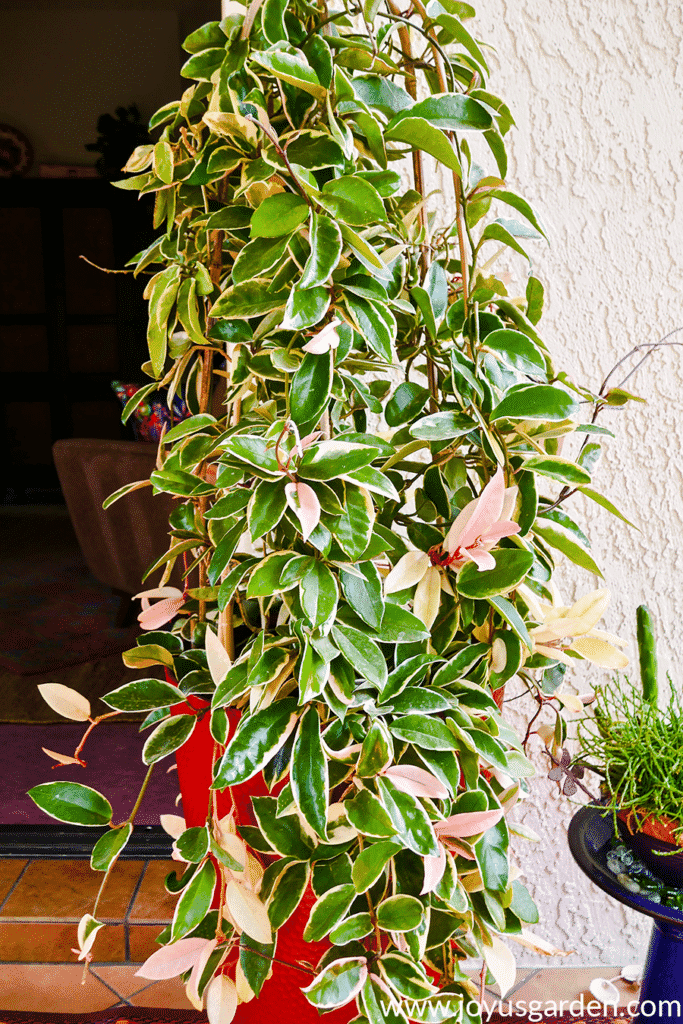
This is my Hoya carnosa “variegata” which grows on my side patio. It lives outside all year long & has really put out a lot of new growth this spring. You can see why I love it!
When is the Best Time for Hoya Houseplant Repotting?
Mid-March through the end of July. I repotted my 2 in mid-May but could have done it in March here in Tucson. It’s best to wait until the temperatures have warmed and the days have gotten a bit longer.
Avoid repotting your hoya in winter as it’s the time for houseplants to rest.
How Often Do You Need to Repot Your Hoya?
In a nutshell, don’t rush to repot yours. Hoyas don’t need it every year. They prefer growing a bit tight in their pots.
Hoyas don’t have an extensive root system. Many of them are epiphytic which means their roots are used primarily for anchoring.
As I said, I repotted these because the mix they were growing in looked depleted. This was especially true of the Hoya obavata. You never do know how long as houseplant has been growing in that mix when you buy it.
As a general rule, I repot my smaller hoyas every 5 years. My hoya topiary is a different. It’s in a tall pot and won’t need repotting for at least 10 years. This is not because the plant will be potbound but because I want it to have fresh mix. In the meantime, I nourish it with worm compost and compost every spring.
How Big Should the Pot Be?
I only went up a pot size with these 2 hoyas. They don’t need a huge base to anchor them.
It’s a different story with my topiary. It’s growing on 40″ bamboo hoops and needed a bigger base as it grew. Let’s be honest here, I love the look of the tall hoya growing in the tall pot.
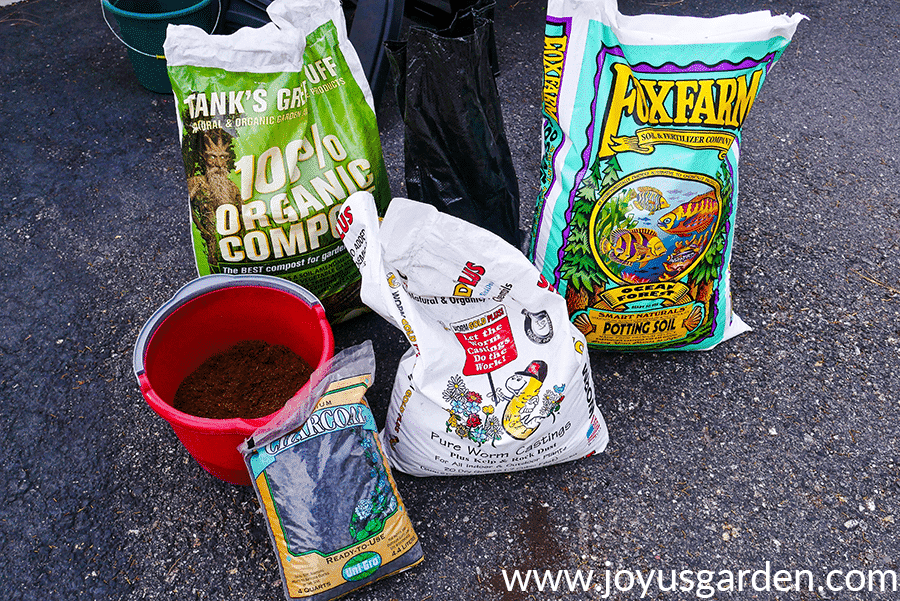
Here are the ingredients for the mix below. Coco coir is in the red pail & my homemade succulent & cactus mix is in the black bag.
Here is the Soil Mix to Use for Hoya Houseplant Repotting:
1/2 potting soil
I’m partial to Ocean Forest because of its high-quality ingredients. It’s a soilless mix & is enriched with lots of good stuff but also drains well.
1/2 succulent & cactus mix
I’d been buying a mix from a local source but have just started making my own. Here’s the recipe for DIY succulent & cactus mix in case you want to make your own too: Succulent & Cactus Soil Mix For Pots
A couple of handfuls of coco coir
This is an eco friendly alternative to peat moss. I buy mine locally here in Tucson.
A couple of handfuls of compost
Epiphytes love compost or leaf matter. It mimics the rich plant matter falling on them from above in their natural environs.
A 1/4″ topping of worm compost
This is my favorite amendment, which I use sparingly because it’s rich. I’m currently using Worm Gold Plus. You can read how I feed my houseplants with worm compost & compost here: How I Feed My Houseplants Naturally With Worm Compost & Compost
A few handfuls of charcoal
Charcoal improves the drainage & absorbs impurities & odors. Pumice or perlite up the ante on the drainage factor too. This is optional, like the composts, but I always have them on hand.
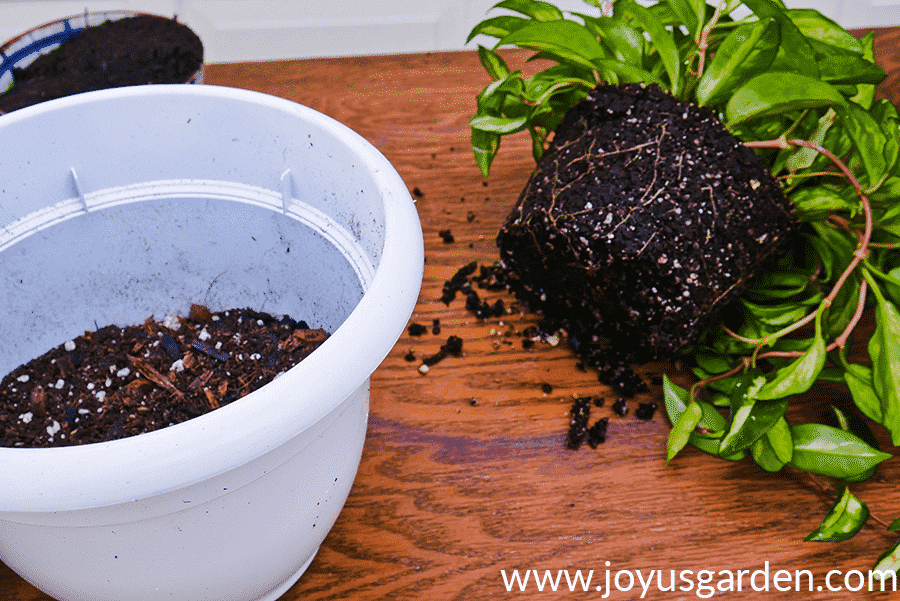
You can see here that my Hoya carnosa “rubra” wasn’t potbound at all. I was wanted to plant it into the white pot & leave it be for at least 3 or 4 years.
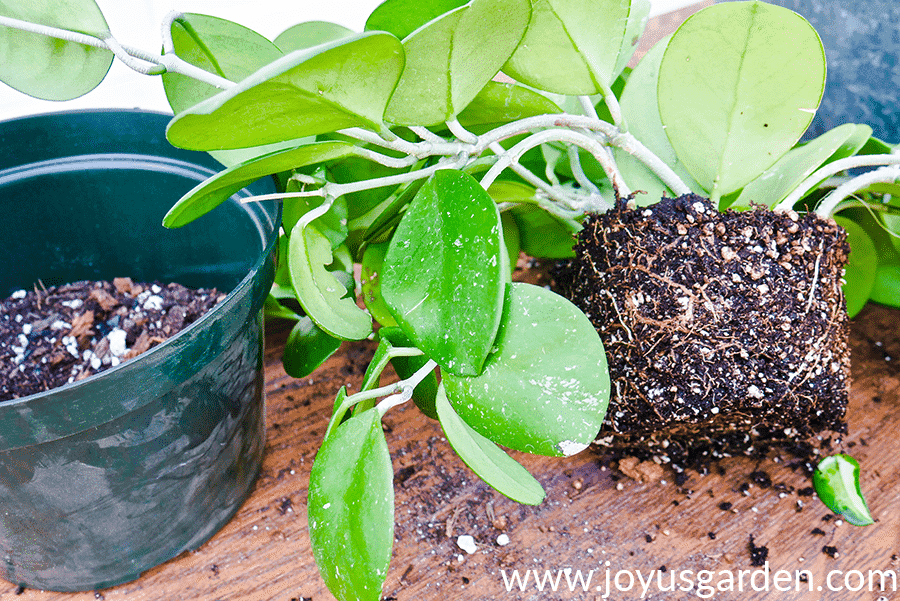
The roots on my Hoya obovata were a bit more extensive. The stems of this plant are thicker too.
Soil Mix Alternatives:
I know many of you live in urban areas and have limited storage space. I know, it was the same for me for many years.
Now I have a garage and more plants than any person needs. But, I want them all and more! I now have a place to store all my materials in and have at least 10 components on hand ready to go.
A good potting soil is fine but it’s better to lighten it as hoyas don’t like to stay wet.
1/2 potting soil, 1/2 succulent & cactus mix
1/2 potting soil, 1/2 fine orchid bark
1/2 potting soil, 1/2 coco coir
1/2 potting soil, 1/2 pumice or perlite
1/3 potting soil, 1/3 pumice or perlite, 1/3 coco coir
How to Repot a Hoya Houseplant:
It’s best to watch the video for this:
Head’s up: I watered my hoyas a few days before repotting them. You don’t want to repot a dry, stressed plant.
After Care:
The root balls were moist when I repotted the plants. I let the plants settle into their new mix for 2-3 days before watering.
I placed them in the spots they had been growing in – bright light but no direct sun.
I water my hoyas once a week here in the desert in the hot, sunny weather. In the winter I water these tropical beauties every 2-3 weeks.
Do you like the hanging tray my Variegated Hoya is growing on in the lead photo? I love it because the tray acts as a saucer in case a little water runs out. The tray is plastic so you can easily spray paint it & it’s not heavy at all.
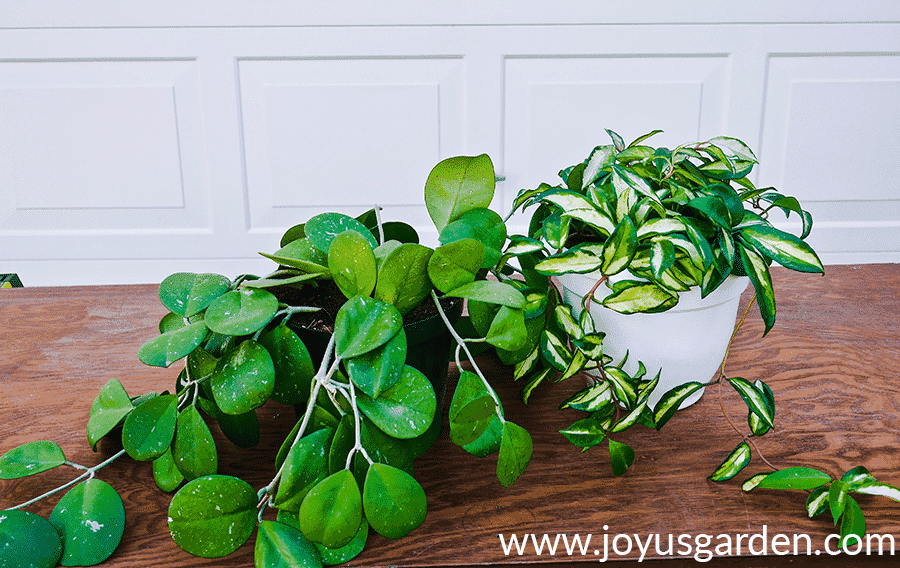
The 2 hoyas all repotted & ready to go back in the house. The Hoya obovata is on the left & the carnosa “rubra” on the right.
My Hoya obovata and Hoya carnosa “rubra” are happy as can be now in their fresh new mix. I’m looking forward to getting 2 or 3 more hoyas when I find some which catch my fancy. Are you a hoya fan too? Never enough I say!
Happy gardening,

How to Care for a Hoya Houseplant
Care Tips For Growing Hoya Plants Outdoors
How I Prune, Propagate & Train My Stunning Hoya
7 Easy Tabletop & Hanging Plants For Beginning Houseplant Gardeners
Repotting Peperomia Plants (Plus The Proven Soil Mix To Use!)

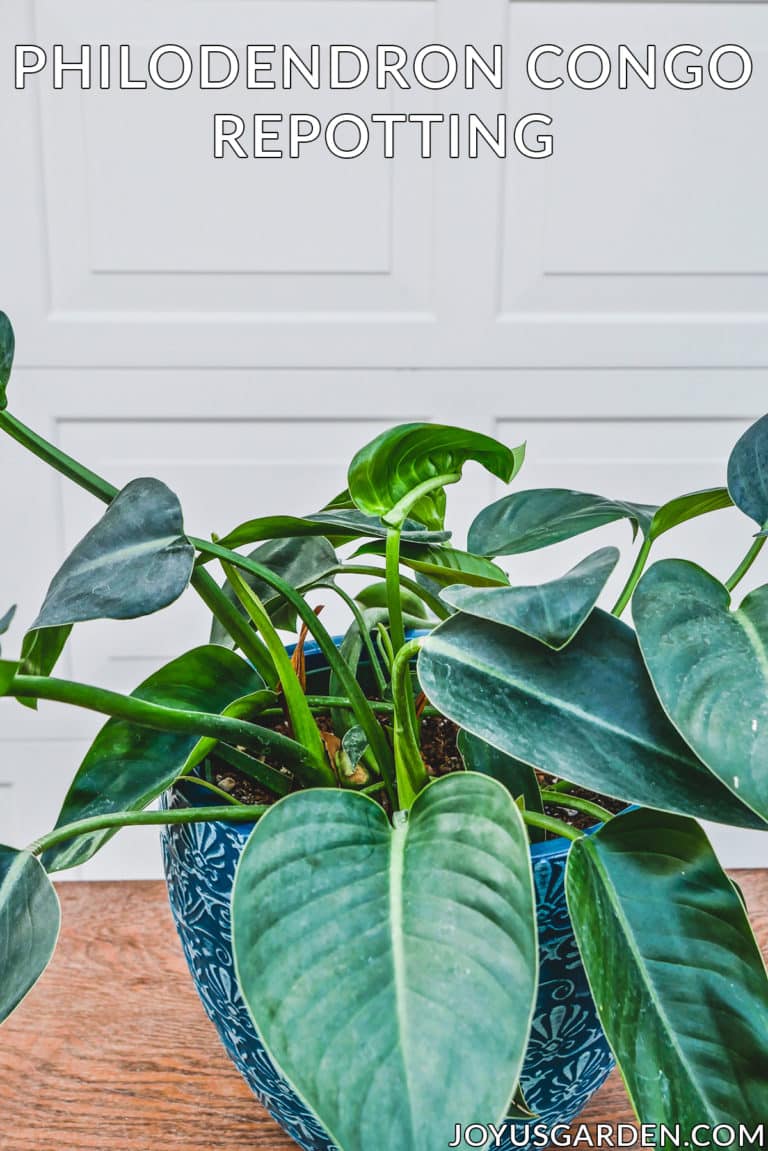
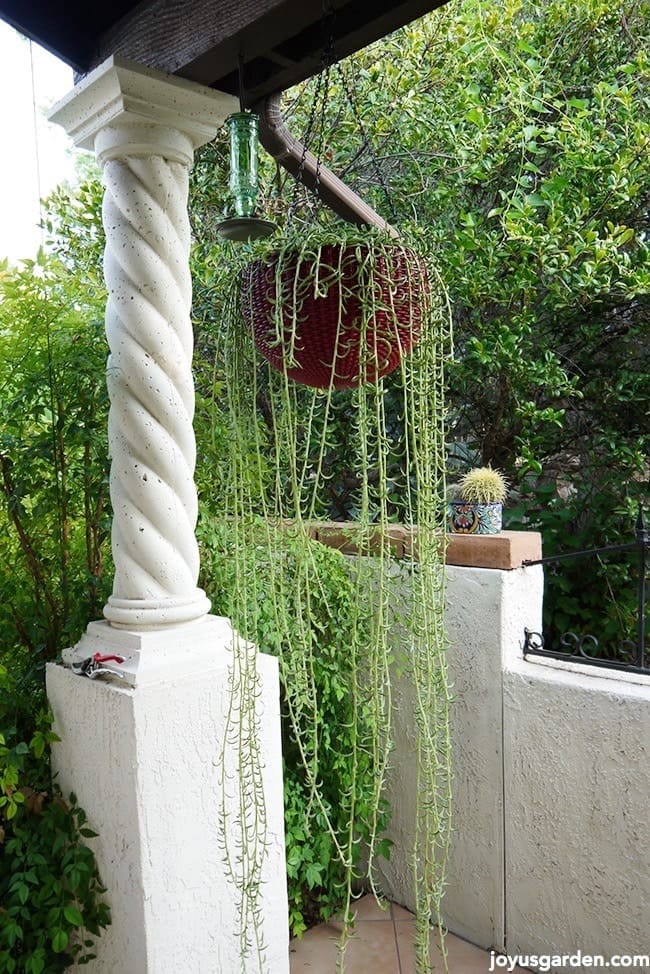
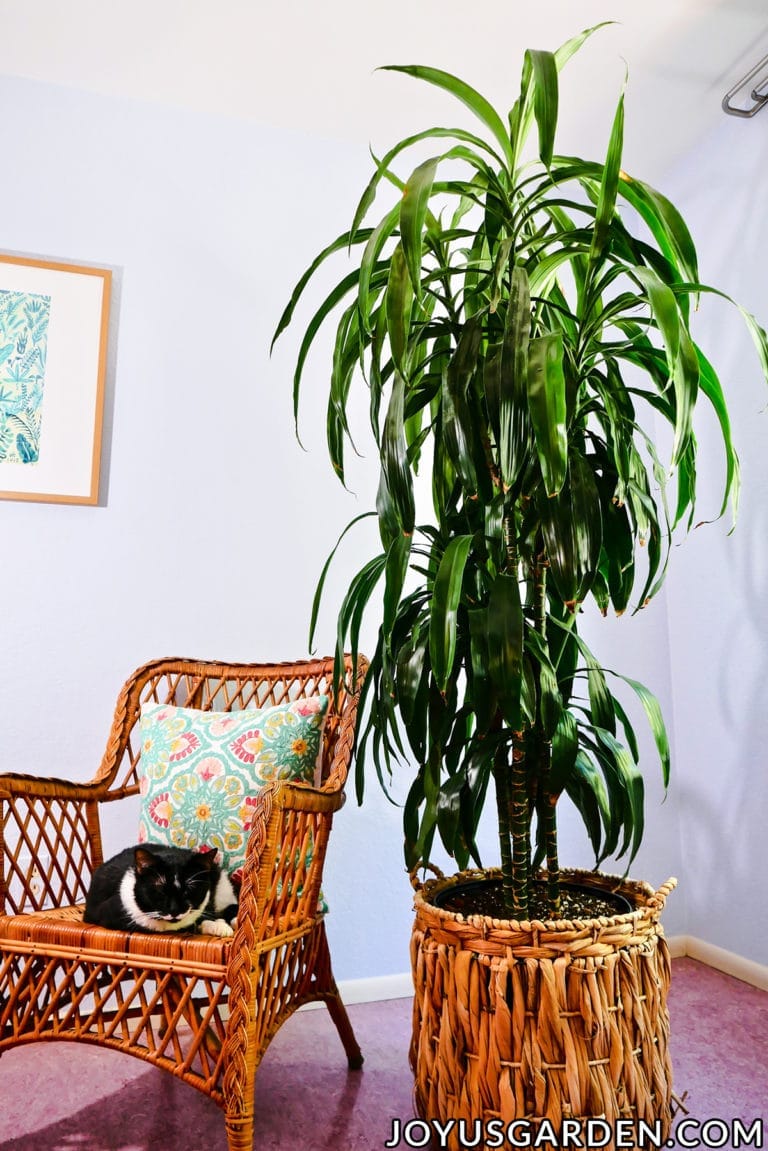
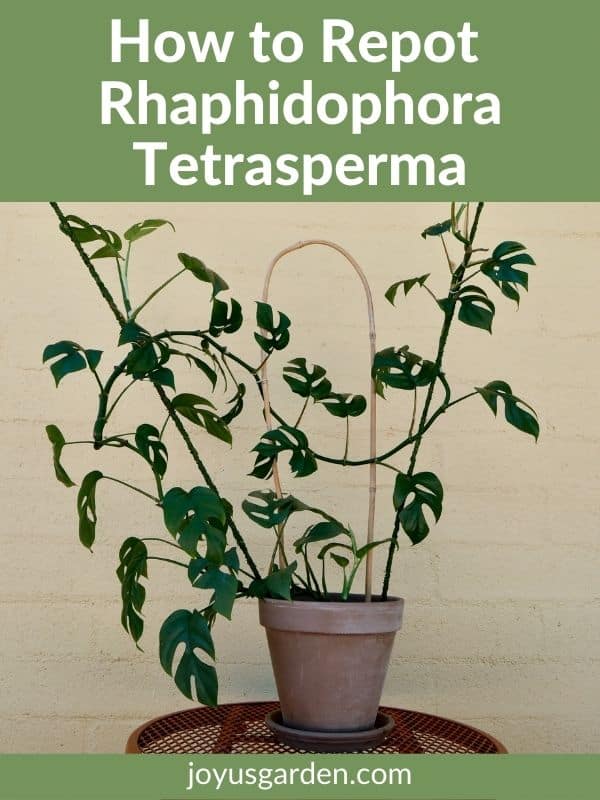

Good morning, Ms Nell.
Wow what a lesson, you give great instructions
I could set n your class all day.
.u are funny u kept me from going to sleep. Lol.
Continue to be the great instructor u are.
Never stop sharing.
Ms Holley from NJ.
Ms. Holley – I need things spelled out clearly & simply when I’m learning something new. And, that’s what I try to do here. Thank you for your kind words! Nell
Hi Nell! I have been following you for a while on Pinterest, and I really enjoy your videos and information. I just moved back to Tucson after 35 years, and glad to be back home! I cannot garden outside anymore, a passion I developed living in Georgia. So, I am moving my interests to indoor gardening. Thank you for all the Tucson references; they are helping my thought process in what I want to consider appropriate for our climate. Thank you for all you do!
Carol – Welcome back to Tucson! I like to refer to it because living in the desert is a whole different gardening bag. I’m always happy to share Z& thanks for reading. Nell
Good Evening Nell I am new to your post discovered after I bought these amazing Hoya plants I’ve never seen or heard of before. Just want to give them a loving home and very interested in the products you mentioned here. May I ask if you have a favorite dependable supplier or nursery in Tucson? I am local also. Thanks again for the great information. JL
Hi – Hoyas do great here in Tucson. I have 6 of them. You can check Green Things or Mesquite Valley here in town. I brought 2 of mine from Santa Barbara when I moved & got 1 at Green Things & the others in Phoenix & San Diego. Nell
Hi Nell! I wish you gave live classes for people in Tucson. I am trying to do a Hoya topiary, but struggling.
I should Beth. Perhaps a nursery would host it outdoors. Nelll